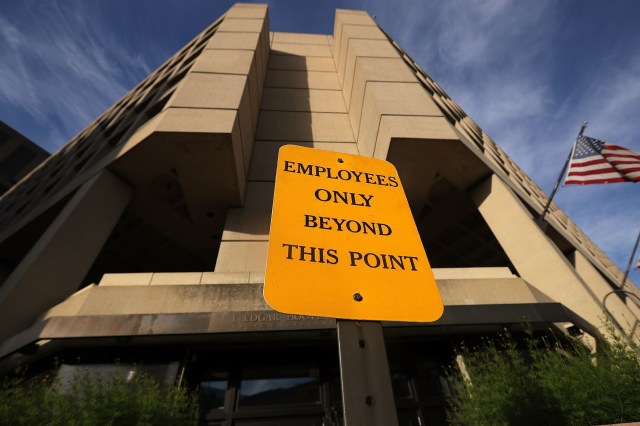Donald Trump hates the Brutalism of the Edgar J. Hoover Building. Credit: Chip Somodevilla / Getty

Brutalist architecture is cool again. (Who decides these things I don’t know, but I suspect it’s the kind of people who do the whole urban thing in their twenties before decamping to a leafy suburb or the countryside in their thirties.)
Brutalism’s trendiness won’t be damaged by the fact that Donald Trump doesn’t care for it. His particular bugbear is the J Edgar Hoover Building, the FBI’s HQ – just down the road from the White House.
This is how Jonathan Swan reports the story for Axios:
“In the midst of one rant about the FBI, he lit into the building. ‘Even the building is terrible,’ he observed to an Axios source. ‘It’s one of the brutalist-type buildings, you know, brutalist architecture. Honestly, I think it’s one of the ugliest buildings in the city.’”
Swan goes on to report another source as saying that the President wants to personally oversee a redevelopment at an “excruciating level of detail.”
Commenting on the story for Slate, Henry Grabar associates brutalist buildings with an “idealistic vision of what government can and should take responsibility for”. If, however, you don’t like modernism then, watch out, you could be a fascist:
“The far right appears to be leading a broader backlash against architecture self-evidently built with 20th-century technology. Such structures, in addition to their perceived deviance from the ‘Western traditions’ venerated by American fascists, represent the tastes and lifestyles of America’s treacherous urban elite.”
The relationship between fascism and architecture is far from straightforward. On the one hand, there’s the fascist predilection for monumental pseudo-classical designs (for instance, Hitler’s plan for the redevelopment of Berlin – ‘Welthauptstadt Germania‘); on the other hand, fascists were also promoters and patrons of modernist architecture. For instance, the Casa del Fascio in Como is regarded as a model of 1930s modernism (and bears more than a passing resemblance to some of the buildings I see going up in London today).
And let’s not forget that Le Corbusier, a pioneer of various modernist styles, including brutalism, was also a fascist and an antisemite. Should we separate the man and his work from his politics? Personally, I’m disinclined to – not when his architectural vision so vividly embodies the totalitarian impulse to erase the past and dominate the future.
Grabar, for his part, is focused on the present. He invites us to contrast the “bold, uncompromising shape” of brutalist buildings and their “dynamic patterns of sun and shadow” with the “reflective expanses” of the blank, glassy towers of contemporary corporate architecture (as exemplified by New York’s Trump Tower). “All that reflective glass,” he says, is a “metaphor for the hidden flows of capital that make the towers pencil out.”
He compares the aesthetic to “the aviator sunglasses favored by state troopers nationwide”. That’s an appropriately uncompromising image of power, though I’d personify such a building not as an officer of the law, but as a rich jerk in a sharp suit and mirror shades – the kind of guy who looks down on the ‘little people’, while avoiding all contact with them. Brutalist buildings, in clear distinction, very much want to involve themselves in our lives (though, admittedly, the same could be said of a mugger).
Grabar quotes the architecture critic Alexandria Lange:
“My theory about why we love concrete architecture now is simple: It has body… Even as we consume design in pixels, we long for spaces where we can feel the weight of the world.”
He concludes with a related observation of his own :
“In a world wrapped in glass that masks where weight really falls, a big chunk of concrete sometimes just feels honest.”
Honesty is a personal characteristic, so let’s go back to the idea of buildings as people – and how they ought to behave. When in the presence of others, a considerate individual should neither ignore those around him, nor impose himself upon them.
That might seem an old-fashioned idea of good manners, but it would explain why old-fashioned buildings succeed where the towers of glass or concrete so miserably fail.










Join the discussion
Join like minded readers that support our journalism by becoming a paid subscriber
To join the discussion in the comments, become a paid subscriber.
Join like minded readers that support our journalism, read unlimited articles and enjoy other subscriber-only benefits.
Subscribe